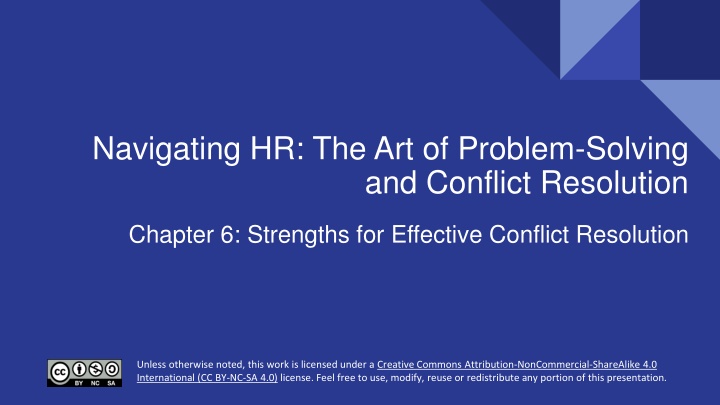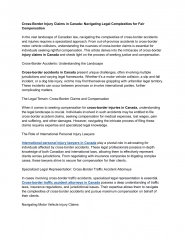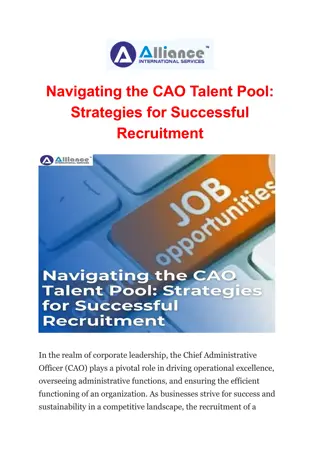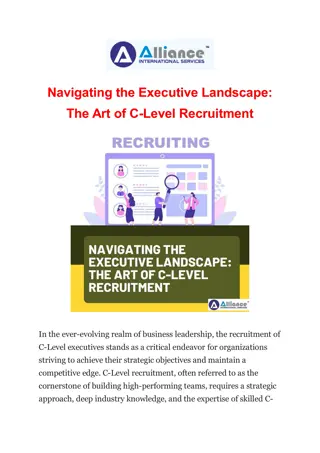
Effective Conflict Resolution Strategies in Human Resources
Explore the key elements of professionalism in conflict resolution, emphasizing trust's role, impact, and emotional aspects. Learn about building trust through sincerity, reliability, competence, and care in HR practices.
Download Presentation

Please find below an Image/Link to download the presentation.
The content on the website is provided AS IS for your information and personal use only. It may not be sold, licensed, or shared on other websites without obtaining consent from the author. If you encounter any issues during the download, it is possible that the publisher has removed the file from their server.
You are allowed to download the files provided on this website for personal or commercial use, subject to the condition that they are used lawfully. All files are the property of their respective owners.
The content on the website is provided AS IS for your information and personal use only. It may not be sold, licensed, or shared on other websites without obtaining consent from the author.
E N D
Presentation Transcript
Navigating HR: The Art of Problem-Solving and Conflict Resolution Chapter 6: Strengths for Effective Conflict Resolution Creative Commons Attribution-NonCommercial-ShareAlike 4.0 International (CC BY-NC-SA 4.0) Creative Commons Attribution-NonCommercial-ShareAlike 4.0 International (CC BY-NC-SA 4.0) Unless otherwise noted, this work is licensed under a Creative Commons Attribution-NonCommercial-ShareAlike 4.0 International (CC BY-NC-SA 4.0) license. Feel free to use, modify, reuse or redistribute any portion of this presentation.
6.0 Learning Outcomes In this chapter, we will: Explain the strengths necessary to address problem-solving and conflicts in the workplace. List the costs and risks to a business when workplace issues are not addressed on time. Demonstrate your timely problem-solving and conflict-resolution approach by applying this skill to a business scenario.
6.2 The Lesson: Strengths for Effective Conflict Resolution What does it mean to be professional ? According to Dale Atkins, being professional consists of four key elements. Knowing: Human Resources professionals acquire, understand, and share knowledge as subject matter experts to analyze and resolve challenges, such as applying the Thomas- Kilmann conflict resolution approaches. Doing: Professionals actively apply their knowledge to lead by example and implement solutions, resolving issues like workplace conflicts using tailored Thomas-Kilmann strategies. Helping: By solving problems and improving situations, professionals assist individuals and organizations, addressing specific needs to reduce or resolve conflicts effectively. Learning: Professionals commit to continuous education, staying updated on evolving trends, such as AI, to address future challenges and improve conflict resolution skills.
6.2 Trust Role of Trust in HR: Human Resources professionals rely on trust and credibility to guide employees and leaders in problem-solving and conflict resolution. Impact of Trust: Trust positively influences job satisfaction, performance, organizational commitment, revenue, and profit, as well as prosocial behaviours like collaboration and helping others. Interpersonal Trust: Trust involves accepting vulnerability based on the expectation of positive outcomes from another's actions, such as trusting a group member to meet deadlines. Distrust: Distrust arises from believing that important values are unsafe with someone, leading to self-protection and guarded behaviour. Emotions Associated with Trust: Trust fosters care, openness, curiosity, cooperation, collaboration, and positive expectations. Emotions Associated with Distrust: Distrust leads to defensiveness, blame, judgment, withholding information, and expecting negative outcomes.
6.2 Building Trust Feltman (2011) shares a model in which the choice to trust comprises four distinct aspects of how a person might act. The four aspects are as follows: Sincerity: Trust is based on honesty, truthfulness, and evidence-supported opinions, such as a manager sharing researched strategies to overcome challenges. Reliability: Trust grows when commitments are kept, like a friend following through on scheduling plans. Competence: Trust requires confidence in someone's skills and knowledge, such as a chairperson effectively planning social media. Figure 6.2.1 Model of Trust Adapted from Feltman (2011) Care: Trust involves considering others' interests, as seen when a friend shares a scholarship opportunity they are also pursuing.
6.2 Building Trust in Teams Building Trust: Trust is essential for both manager-employee and team relationships, as it underpins communication and project success. A recent survey published in the Harvard Business Review by Ron Friedman (2024) identified the following five key behaviours of high-performing teams: High-Performing Teams Don t Leave Collaboration to Chance. They discuss how they will work together first. High-Performing Teams Keep Colleagues in the Loop. A culture of inclusion is created. High-Performing Teams Share Credit. Share recognition for the success of the project. High-Performing Teams Believe Disagreements Make Them Better High-Performing Teams Proactively Address Tension 1. 2. 3. 4. 5. Trust develops naturally through behaviours shared by all team members, enabling everyone to bring their best to the team.
6.2 Strengths You Can Rely On Tact: The Human Resources professional should know what to say to maintain the relationship and keep the conversation alive. Diplomacy: The Human Resources professional should be sensitive to the perspective of the person you are interacting with to ensure an effective outcome. Confidentiality: Human resources professionals should protect sensitive information to build trust with everyone involved. Flexibility: The Human Resources professional should recognize the need to be flexible and change as the situation changes. Ethical: Human Resources professionals should conduct themselves in a moral and legally compliant manner. Impartiality: The Human Resources professional should focus on the people and the facts. There is no room to insert your thoughts and opinions; you should avoid personal bias.
6.3 Spotlight on Human Resources Skills As a Human Resources professional responsible for helping others solve problems and resolve conflicts, acting promptly is essential. Once you learn of a negative workplace conflict, time is of the essence. Let s learn about the positive impact of a timely solution to a conflict scenario. It is essential to consider what might happen if we promptly fail to address problems and conflicts.
6.3 A Timely Approach Escalation: Minor conflicts can quickly escalate, involving more employees and complicating the issue. HR professionals must act promptly to prevent small problems from becoming major disruptions. Recollection: Gathering information quickly preserves accurate details from involved parties and witnesses. Delayed action risks losing critical facts, compromising the integrity of the case. Productivity: Workplace conflicts consume time and focus, lowering the productivity of those involved. Timely conflict resolution minimizes broader distractions and productivity losses. Reasons to Address Conflict in a Timely Manner by Connie Palmer, CC BY-NC-SA
6.3 A Timely Approach (continued) Costs: Conflicts lead to both direct costs, like legal fees, and indirect costs, like morale decline. Quick intervention helps control organizational expenses and prevent financial strain. Risk: Addressing conflicts promptly reduces exposure to legal and reputational risks. HR professionals play a key role in mitigating risks by resolving workplace issues effectively. Reasons to Address Conflict in a Timely Manner by Connie Palmer, CC BY-NC-SA
6.6 Key Takeaways Focusing on strengths such as tact, diplomacy, and confidentiality will assist a Human Resources professional when dealing with workplace conflict. You don t want to allow a workplace issue to grow into an even bigger problem. If you need to conduct a workplace investigation, you want to do so as soon as possible to ensure everyone, including witnesses, can recall the details of the matter. Consider the loss of productivity as employees spend time talking about workplace conflicts. There is an indirect cost to workplace conflict, such as the moral Direct costs to the business may include productivity and turnover


















